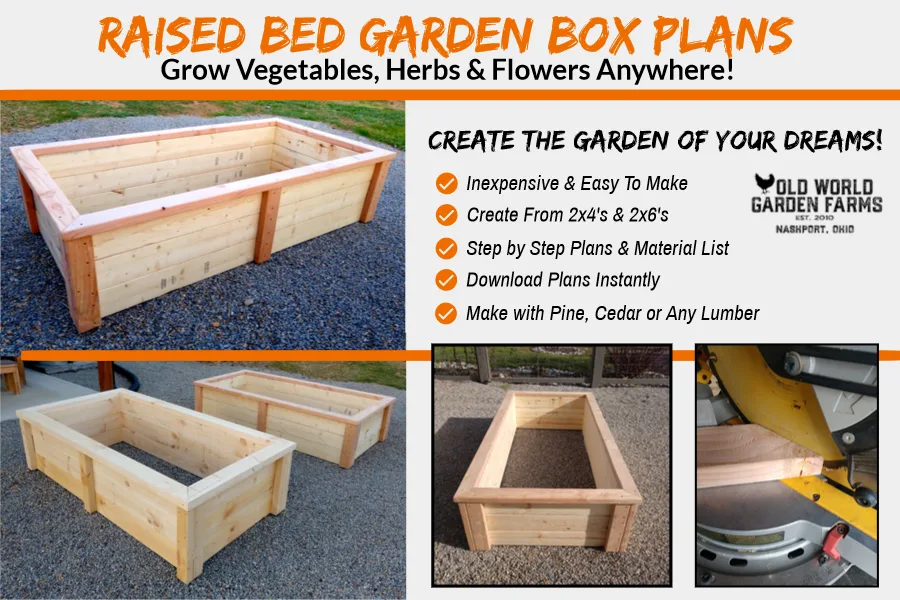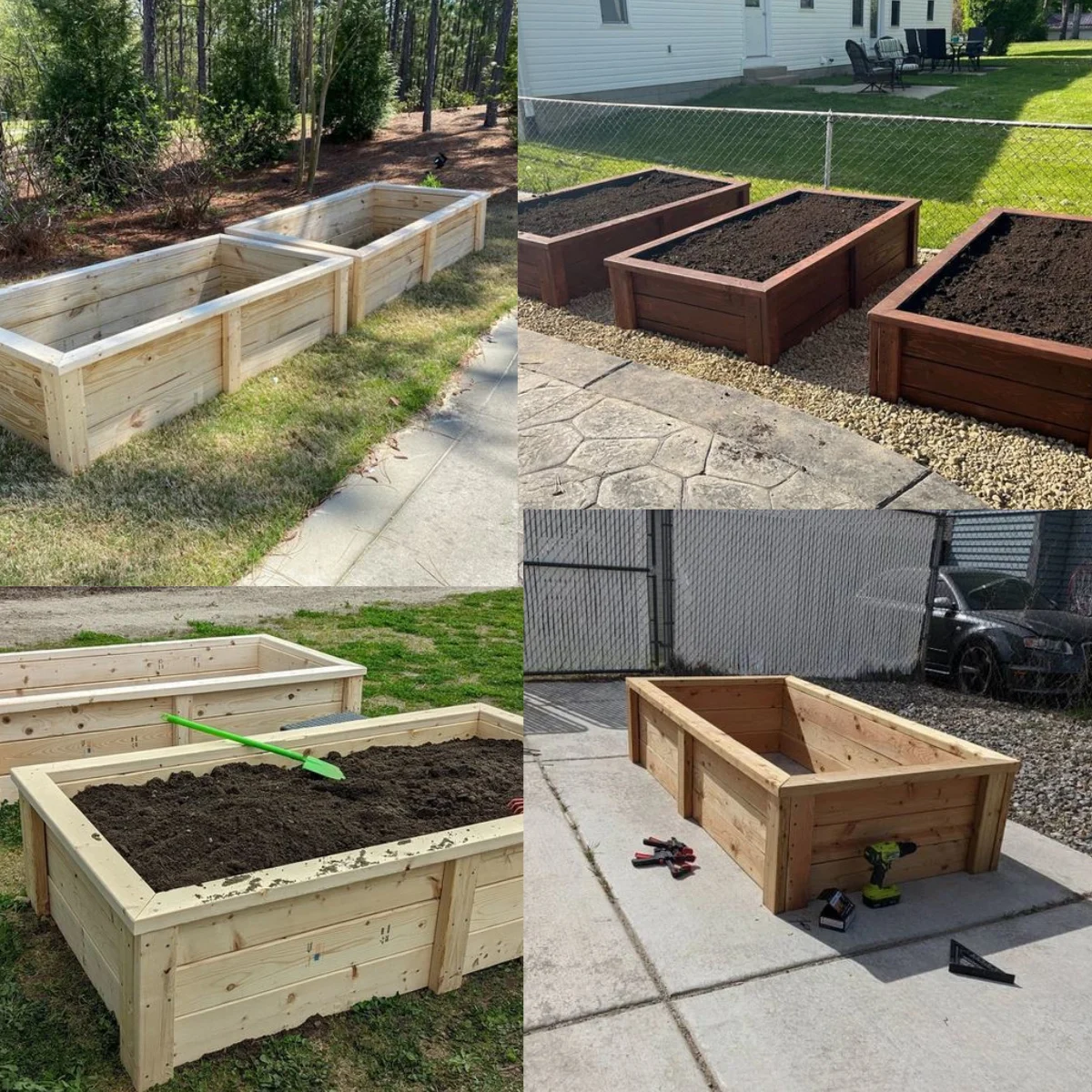If there is one thing that always seems to catch the eye of those walking through our test gardens at the farm, it is our homemade raised bed garden boxes – and it doesn’t take long for those who notices our DIY garden boxes to ask just how easy and expensive it is to build them.
Raised bed gardening has so many advantages for so many different gardening situations. For those with mobility issues, it brings the garden up – taking away the difficult chore of kneeling or bending over to plant, water, weed and harvest.
But beyond being easier to work, raised beds also are great for creating a garden space where no soil exists. When deep enough, they can be placed on patios, concrete or gravel. And by their very nature of being off the ground, raised beds also have the advantage of having far fewer weeds and weeding issues than a traditional garden.
Creating A Low Cost Raised Bed Garden Box
So what’s not to love about this incredible way to grow? For many, the drawbacks come down to three important factors – the cost of raised beds, their appearance, and their long term durability.
Let’s face it, some commercially available raised beds can be astronomical in price. And beyond that, many that are made of plastic, thin wood or metal don’t look exactly look attractive. Nor do they stand up to the test of time very well either.
For all of those reasons above, we decided some years back to create our own homemade version from wood. Our intent was to create them with a simple construction process that made building easy. And even more, to use ordinary 2×4 and 2×6 lumber to keep them both cost effective and durable.
The real challenge was to try to make them also look appealing to the eye and also 100% functional. And by functional, that means big enough to grow any vegetable you wanted, including large heirloom tomatoes.
A Simple, Low Cost Way To Build A Raised Bed Garden Box
We wanted a raised bed design that would be easy to build and even easier on the budget. In addition, we also had to make it be deep enough to allow for strong root growth. At the same time, we also needed to make sure that each raised bed was long and wide enough to grow a lot of plants, but still be able to work from either side.

Using a simple stack design that then locks together with side rail support, we ended up creating 3′ wide x 6′ long x 18″ deep raised beds. Each 3′ x 6′ raised bed allows for 18 square feet of planting surface. They are perfect for growing vegetables, greens, planting an herb garden, or growing all kinds of flowers.
Deep Soil Grows Deep Roots – How To Build Raised Bed Garden Boxes
The 18″ depth of the unit allows for incredibly deep roots, which is ideal for growing large vegetables. And although you can easily adjust the plans to create wide or longer beds with ease, the 3′ width makes tending to plants a breeze. They are also easy to make longer by simply using 8′ or 10′ boards on the side instead of six foot long boards.
But what really makes the beds unique is the decorative 2×4 top ledge and side supports. It gives the beds a great look and also help keep them strong and true. 2x construction really is the key!
The raised beds have been a hit in the test garden – and for many others that have now built them all over the country using the plans. One thing is for sure, we have certainly loved the hundreds of photos we receive seeing the raised bed boxes in action!
Creating Your Own Homemade Raised Bed Garden Box – How To Build Raised Bed Garden Boxes
Here is a look at exactly what goes into the raised beds and the process to build them. We also have a video below that shows them in more detail as well.
The beds use just (3) 2 x 6 x 12’s, (2) 2 x 6 x 10’s, and (5) 2 x 4 x 8 boards to create the entire unit. Although traditional untreated lumber works great, you can also substitute rough-sawn or even cedar if you wish.
The raised bed boxes are easy to create with the most basic of tools. In fact, all you need is a tape measure, a drill, drill-driver and a saw. We do have complete step by step plans in our Etsy shop that include material list, cutting and assembly instructions: DIY Raised Bed Plans
We prefer using traditional lumber or untreated rough-sawn lumber simply for cost. And because neither contain harmful additives, there are no worries when growing vegetables or herbs.
As for the long term durability of untreated pine 2×6 and 2×4’s, they holds up very well over time. Especially if you stain, seal or paint the exterior edges that do not come in contact with the soil. Our beds have now been in place for 6+ years and still look great.
Raised Bed Plans

Using untreated rough-sawn wood will even add a longer shelf life. The non-smooth surface is a naturally protective barrier that holds up even better to the elements. Local saw mills are a great place to source rough-sawn lumber.
No matter if you use traditional 2x lumber or rough-sawn, these DIY raised beds will hold up for years and years. Unfortunately, many of the raised beds available in stores use 1x material, which simply doesn’t stand up to the outdoors.
Completing The Project – How To Build Raised Bed Garden Boxes
After cutting all of the lumber to size, assembling it together is a snap. The 2×6 boards are placed together into a rectangle, and 2×4’s are then attached around all of the corners and mid-sections.
To complete it all, a 2×4 decorative top rail goes on top and goes together with screws. Not only does the top rail serve as a nice finish for the piece, it also helps shed water off of the exposed leg posts. This too helps keep the piece stronger over time.
You Can Check Out Our Raised Beds On YouTube Below!
You can then paint, stain, or leave the exterior of the DIY Raised Bed Boxes to weather to a natural grey. All that is left is to fill them up with some great soil, and your garden is ready to grow! See: How To Fill Your Raised Beds Right – How To Create Incredible Raised Bed Soil!
Here is to building your own DIY homemade raised bed garden boxes this year, and to growing better and more easily than ever! Happy Gardening – Jim and Mary
Old World Garden Farms
Jim and Mary Competti have been writing gardening, DIY and recipe articles and books for over 15 years from their 46 acre Ohio farm. The two are frequent speakers on all things gardening and love to travel in their spare time.
As always, feel free to email us at thefarm@owgarden.com with comments, questions, or to simply say hello! You can sign up for our free email list in the subscribe now box in the middle of this article. Follow us on Facebook here : OWG Facebook. This article may contain affiliate links.


